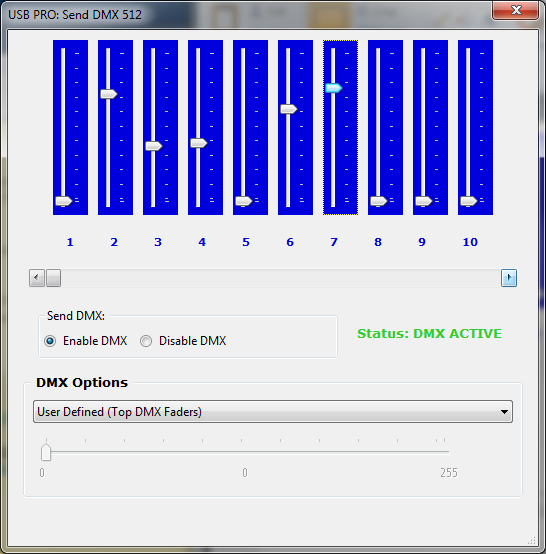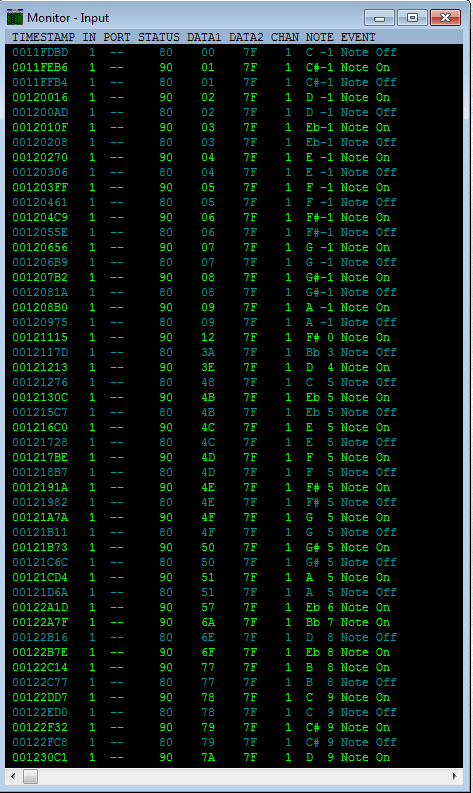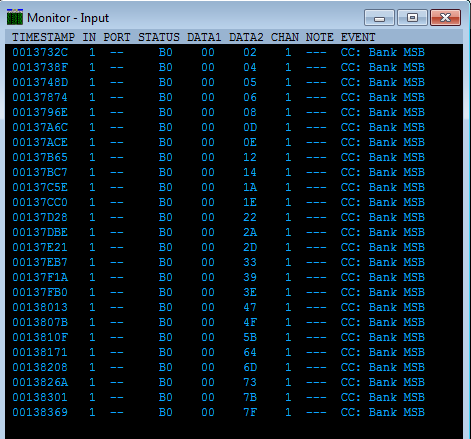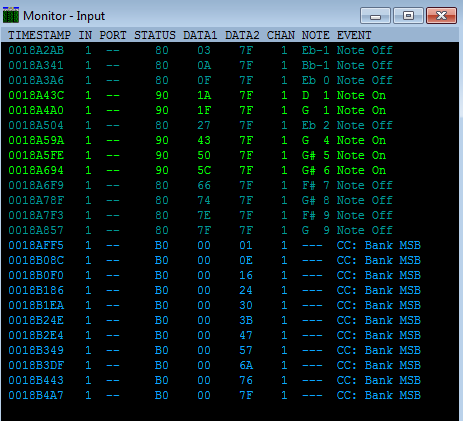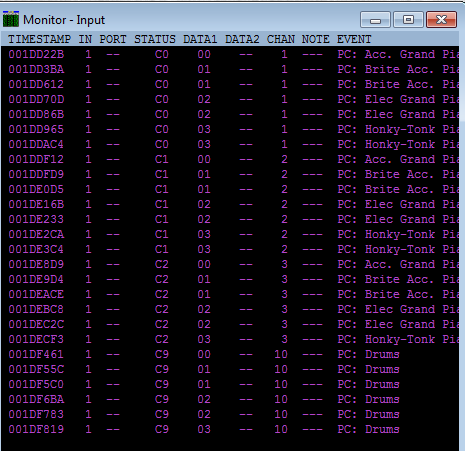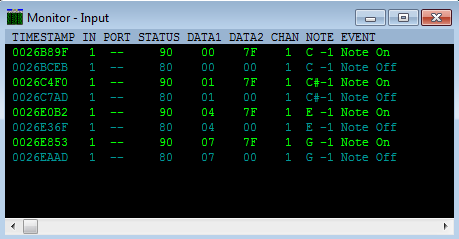Output Modes
For convenience here, a PC-based DMX output utility was used to generate various DMX channel:value pairs.
Using the built-in LCD, set the operating mode and DMX start address for the system. Different modes require varying quantities of DMX data, as described below. In the charts below, 'Channel 1' means 'system start address'. So if the DecaBox is set to start address 10, channel 1 means channel 10. Make sense?
The word channel means something different in the MIDI and DMX worlds. A MIDI channel is most easily compared to a DMX universe. Messages in a single MIDI channel can contain note on / note off information, continuous controller data, patch change messages, etc. However, a single MIDI cable can contain data for all 16 MIDI channels while a DMX cable only controls a single universe [512 DMX channels] of data.
Also, MIDI is a zero-based system. That is, the first MIDI channel is '0' and the last is 15, or 'F' in hex code. Note values and velocities vary between [0 127] or [0x0 0x7F] in hex. In the screen captures below, hex, zero-based data is displayed.
This simple PC-based DMX controller from ENTTEC allows precise channel:value control for testing.
Mode 1: Everything
This is our most verbose mode. Sixteen sequential DMX channels generate note on / note off pairs for all 128 notes in a MIDI scale, and all 16 channels in the MIDI world. Then an additional 119 channels generate all 119 general-purpose MIDI CC messages.
| DMX Channels Required | 135 |
| DMX Channel | MIDI Output |
| 1 | MIDI channel 1, Note on / note off pairs, 128 total notes. |
| 2 | MIDI channel 2, Note on / note off pairs, 128 total notes. |
| ... | |
| 16 | MIDI channel 16, Note on / note off pairs, 128 total notes. |
| 17 | MIDI CC #0, values [0 127]. |
| ... | ... |
| Channel 136 | MIDI CC #128, values [0 127]. |
Here DMX channel 1 fader was run somewhat smoothly from 0 to 100%. The entire MIDI scale, with some skipping due to how quickly the fader moved, is represented.
Here DMX channel 17 fader was moved. This corresponds to MIDI CC #0, 'Bank Select MSB.'
Mode 2: Easy Note & CC Messages
Mode 2 is very compact: 2 sequential DMX channels generate all note on / note off pairs for MIDI channel 1 and MIDI CC #0.
| DMX Channels Required | 2 |
| DMX Channel | MIDI Output |
| 1 | MIDI channel 1, Note on / note off pairs, 128 total notes. |
| 2 | MIDI CC #0, values [0 127]. |
Again, values are missing because the fader was run quickly between [0 100%]. However, all values are available.
Mode 3
Mode 3 is a happy medium: Two sequential DMX channels generate note on / note off pairs for all 128 notes in a MIDI scale on MIDI channels 1 & 2. Then an additional 6 channels generate the first 6 general-purpose MIDI CC messages.
| DMX Channels Required | 8 |
| DMX Channel | MIDI Output |
| 1 | MIDI channel 1, Note on / note off pairs, 128 total notes. |
| 2 | MIDI channel 2, Note on / note off pairs, 128 total notes. |
| 3 | MIDI CC #0, values [0 127]. |
| ... | ... |
| 8 | MIDI CC #6, values [0 127]. |
Mode 4: Program Change / Patch Change Messages
Simple, here. 16 DMX channels generate all patch change / program change messages on MIDI channels [1 16]
| DMX Channels Required | 16 |
| DMX Channel | MIDI Output |
| 1 | MIDI program change, MIDI channel 1 |
| ... | ... |
| 16 | MIDI program change, MIDI channel 16 |
Mode 4 data, showing PC messages sent on MIDI channels 1, 2, 3 and 10.
Mode 5: Note On / Note Off With Fixed Velocities
Simple, here. 128 DMX channels generate 'note on' messages when DMX values are 100% and 'note off' messages when values are 0%. A popular TV show requested this mode for triggering sound effects via bump buttons on a console.
| DMX Channels Required | 128 |
| DMX Channel | MIDI Output |
| 1 @ 100% | MIDI channel 1, MIDI note 1, ON |
| 1 @ 0% | MIDI channel 1, MIDI note 1, OFF |
| ... | ... |
| 128 @ 100% | MIDI channel 1, MIDI note 128, On |

